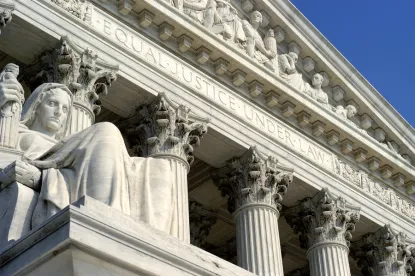Greetings, Court Fans!
While the political branches seized center stage this election week, there has been plenty going on over at The Least Dangerous Branch, as well. Justice Ginsburg might disagree with Bickel’s assessment of the perils of One First Street, having broken three ribs in a fall at work on Wednesday evening. Thankfully, the injury appears unlikely to slow down la famigerata too much; this isn’t the first time she’s bounced back from a few broken ribs, after all (to say nothing of colon and pancreatic cancer). It did keep her from attending the formal investiture of the Court’s newest justice on Thursday, but not from keeping up her practice of authoring the first signed opinion of the term.
At issue in Mount Lemmon Fire District v. Guido (No. 17-587) was whether the Age Discrimination in Employment Act (“ADEA”) applies to all states and their political subdivisions or only to those with more than twenty employees (the numerical threshold that applies to private employers). Believe it or not, there are plenty of political subdivisions with fewer than 20 employees. Among them, the Mount Lemmon Fire District, a political subdivision of Arizona. In the midst of a budget crunch, the Fire District laid off its two oldest (and presumably most expensive) firefighters, John Guido and Dennis Rankin. The pair then sued, alleging that their termination violated the ADEA. The Fire District moved to dismiss, arguing that it was not an “employer” under the ADEA because it had fewer than twenty employees. As the Fire District pointed out, under the ADEA, “[t]he term ‘employer means a person engaged in an industry affecting commerce who has twenty or more employees.” But “[t]he term also means (1) any agent of such person, and (2) a State or political subdivision of a State.” 29 U.S.C. § 630(b). The question, therefore, is whether the ADEA’s numerosity specification, which clearly applies to “a person engaged in an industry affecting commerce,” also applies to states and their political subdivisions. The Ninth Circuit interpreted the “also means” clause as establishing a separate category of employers subject to the Act: The first sentence makes private employers with more than twenty employees subject to the ADEA, while the second sentence reaches agents of employers and states or political subdivisions, regardless of the twenty-employee limitation. But four other circuits (the Sixth, Seventh, Eighth, and Tenth) had interpreted this language differently, reading the “also means” phrase as simply clarifying that states and their subdivisions are “persons” under the first sentence, meaning that the numerical limitation applies to public employers too.
The Court resolved the split in favor of the Ninth Circuit. Writing for a unanimous Court (albeit without Justice Kavanaugh, who did not take part as he had not been confirmed at the time of argument), Justice Ginsburg began with the common meaning of “also”: It is usually a term of enhancement, like “in addition” or “too,” rather than a term of clarification. Interpreting the “also means” language as defining a separate category of employers is supported by numerous other federal statutes whose definitions contain similar “also means” phrases. The courts have generally interpreted those definitions as delineating separate categories. Finally, interpreting the “also means” language as clarifying would be awkward, because the second sentence also includes “agents,” and no one seemed to think the twenty-employee limitation would apply to agents of persons covered by the first sentence.
This all seems to make an awful lot of sense, so you might be wondering why there was a circuit split on this question in the first place. The answer lies in the history of the ADEA and other antidiscrimination statutes, particularly Title VII. When Congress first enacted Title VII in 1964 and the ADEA in 1969, neither applied to public employers and both contained a numerical threshold for private-sector employers. In 1972, Congress amended Title VII to reach state and local employers. It did so by amending the statutory definition of “person” to include government agencies, which had the result of making Title VII’s numerical thresholds apply to public employers too. When Congress amended the ADEA (and, at the same time, the Fair Labor Standards Act) a few years later to reach public employers, it used a different approach: Instead of defining “persons” to include public employers, it added the “also means” sentence to the definition of “employer.” Some courts were reluctant to interpret the ADEA so that it would apply to employers not subject to Title VII, so they interpreted the ADEA amendments as just clarifying the definition of “person” rather than creating a separate category of employers subject to the Act. While RBG took note of this statutory context, she didn’t think it provided a basis to disregard the plain meaning of the ADEA’s definition of employer. After all, the Congress that amended the ADEA plainly knew how a previous Congress had expanded Title VII, and if it wanted to amend the ADEA to match Title VII, it easily could have done so by using the same method of amendment. It didn’t, and that difference had to be respected. Thus, the statute means what it says: States and their political subdivisions are employers subject to the ADEA regardless of the number of their employees.
Though Mount Lemmon is the first signed opinion disposing of a case this term, there have been a few notable opinions and “statements” on the Orders front, as well. Most recently, Justice Sotomayor published a statement respecting the denial of certiorari in Townes v. Alabama (No. 17-7894), where the Court declined to take up a death-penalty challenge hinging on whether the trial court properly instructed jurors that they “may” infer the defendant’s intent to kill a victim or unconstitutionally instructed them that they “must” infer that intent. The Alabama Court of Criminal Appeals initially reversed Townes’s conviction, pointing to a certified transcript reflecting that the trial court gave a mandatory inference instruction, but then the trial judge in question filed a “supplemental record” with the appellate court insisting that the transcript was wrong. The Court of Criminal Appeals then remanded the case and directed the trial court to appoint a new court reporter to retranscribe the proceedings. The second reporter issued a new transcript that differed from the original in precisely one respect: where the original said “must,” the new transcript said “may.” Based on the new transcript, the Court of Criminal Appeals withdrew its reversal and affirmed Townes’s conviction and death sentence. Townes then filed a cert petition and the Supreme Court asked for a copy of the audio recording. But lo!, the Court was informed that the original recording no longer exists. Given the state of the record, Justice Sotomayor agreed that there was not much the Supreme Court could do. “But,” she wrote, “the absence of a demonstrable constitutional error makes the doubts raised by the trial court’s unusual handling of this matter no less troubling.” This is just the most recent of several statements or dissentsfrom denial that SS has penned so far this term, as she stakes out a position as a torchbearer patrolling the Court’s “shadow docket.”
On to grants. The Court has added five cases to its docket since our last Update, including a few that may add some drama to the term. Most notably, in The American Legion v. American Humanist Association (No. 17-1717), the Court will once again give the Lemon test a squeeze, determining whether a 93-year-old World War I memorial violates the Establishment Clause because it is in the shape of a cross. In so doing, the Court will also decide whether the constitutionality of a passive display incorporating religious symbolism should be assessed under the frequently derided test articulated in Lemon v. Kurtzman (1971) or by some other standard. The Court will dust off another old standard in Flowers v. Mississippi (No. 17-9572), where the issue is whether the Mississippi Supreme Court improperly applied Batson v. Kentucky (1986) in the case of Curtis Flowers, who has been tried six times for the same quadruple murder, thanks to the prosecutor’s habit of striking African American jurors. Also on the docket:
- Smith v. Berryhill (No. 17-1606), which asks whether a decision of the Social Security Administration’s Appeal Council rejecting a disability claim on the ground that the claimant’s administrative appeal was not timely filed is a “final decision” subject to judicial review under the Social Security Act;
- Gray v. Wilkie (No. 17-1679), which asks whether the Federal Circuit has jurisdiction under 38 U.S.C. 502 to review an interpretive rule reflecting the Department of Veteran Affairs’ definitive interpretation of its own regulation, even if the VA chooses to promulgate the rule through its adjudication manual;
- Mont v. United States (No. 17-8995), which asks whether a period of supervised release for one offense is tolled under 18 USC 3624(e) during a period of pretrial confinement that upon conviction is credited toward a defendant’s term of imprisonment for another offense.
That’s about all the news that fits in this Update. We’ll be back next Friday (and on a more-or-less weekly basis going forward), with a roundup of the week’s SCOTUS news.





 />i
/>i

